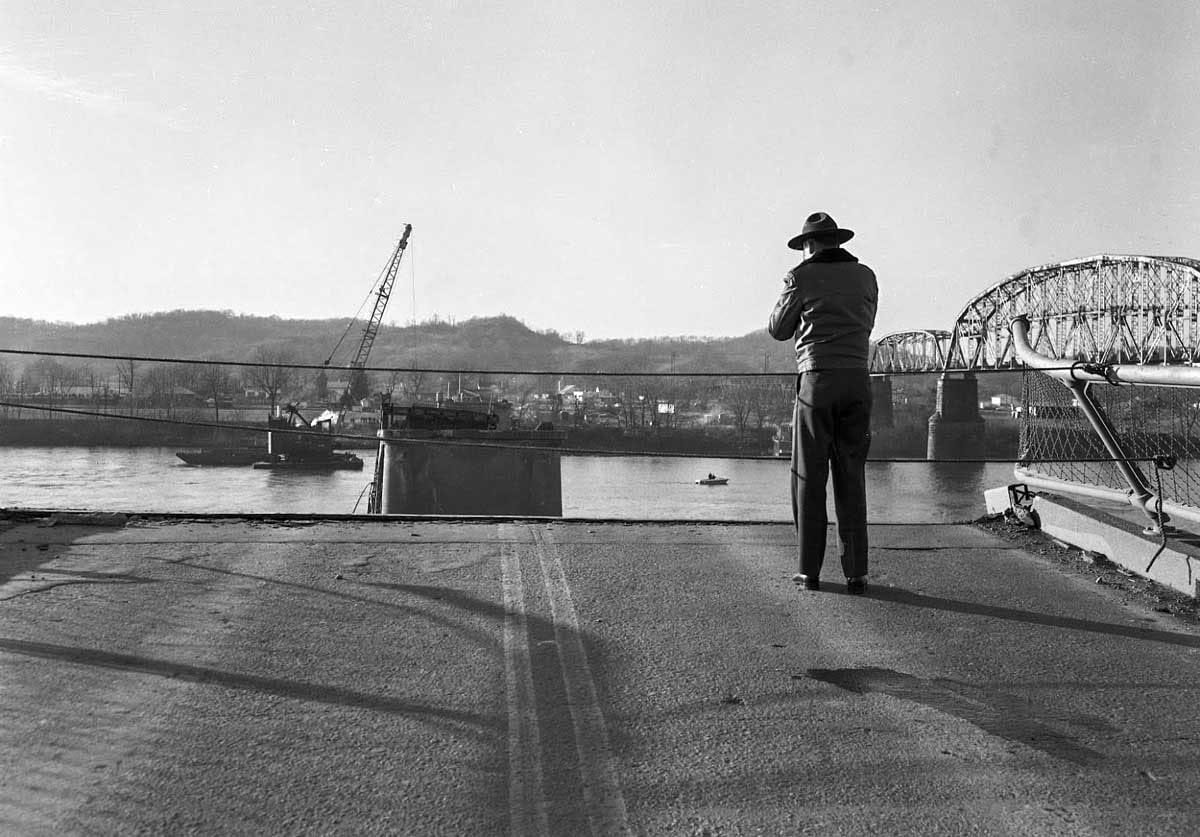A Bridge’s Demise: The Silver Bridge Collapse
The Silver Bridge, a symbol of connection between Point Pleasant, West Virginia, and Gallipolis, Ohio, tragically collapsed on December 15, 1967. During a bustling rush hour, the bridge gave way, sending dozens of vehicles and their occupants into the frigid Ohio River below. This catastrophic event would forever change the landscape of bridge safety standards in the United States.
Built in 1928, the Silver Bridge was a suspension bridge supported by eyebar chains – a design considered robust for its time. However, a hidden danger lurked within one of those eyebars: a microscopic crack, gradually worsening over years of stress and strain. On that fateful December day, the crack finally reached its breaking point, triggering a catastrophic chain reaction that brought the entire structure down.
Eyewitnesses described a chilling scene: the bridge swaying precariously before the final plunge, the deafening roar of metal succumbing to immense force, and the heart-wrenching sight of cars and debris vanishing into the dark water. The collapse claimed the lives of 46 people, leaving a community shattered and a nation in mourning.
The Aftermath: A Turning Point for Bridge Safety
The Silver Bridge collapse served as a brutal wake-up call, exposing the potential for hidden dangers even within imposing structures. This tragedy spurred immediate action. In 1968, the Federal-Aid Highway Act was enacted, mandating rigorous inspection standards for bridges across the country.
The new legislation marked a pivotal moment in infrastructure safety. The Silver Bridge disaster, though horrific, became a catalyst for nationwide improvements in bridge design, construction, and ongoing maintenance.
The term “bridge silver” has come to represent more than just a tragic event; it symbolizes a commitment to learning from past failures and building a more secure future. It stands as a constant reminder that proactive measures, continuous research, and a dedication to innovation are critical in preventing similar tragedies. The legacy of the Silver Bridge lives on in the countless lives saved by improved bridge safety standards and a renewed focus on the vital infrastructure that connects us all.
How Many Survived the Silver Bridge Collapse?
While the Silver Bridge collapse is remembered for its tragic loss of life, there were stories of survival amidst the chaos. Of those present on the bridge that day, 21 individuals miraculously survived.
These survivors’ accounts provide harrowing glimpses into the disaster. Ben Cedar, one survivor, recounted watching in disbelief as cars disappeared into the river. His words, “It was like a nightmare come true,” paint a chilling picture of the scene. Another survivor, Virgil Casto, spoke of an eerie silence following the collapse, where the only sound was the rushing water below — a sound that likely stayed with him forever.
The collapse was not a spontaneous event. The investigation revealed that a tiny, undetected crack in one of the eyebars — critical components responsible for supporting the bridge’s weight — had been slowly growing over time. This seemingly insignificant flaw, exacerbated by years of stress and strain, ultimately set off a chain reaction, leading to the bridge’s downfall.
The Silver Bridge disaster exposed a critical need for stricter bridge inspections and more effective maintenance practices. It forced a reassessment of bridge safety standards across the country. The subsequent implementation of the Federal-Aid Highway Act of 1968, which mandated regular inspections and safety upgrades for bridges nationwide, stands as a silver lining to this dark chapter.
The collapse of the Silver Bridge serves as a solemn reminder to never take infrastructure safety for granted. The 46 lives lost that day weigh heavily on our collective memory, but their memory also fuels our commitment to a safer future. Every bridge crossed and every road traveled is a testament to the lessons learned from that fateful day.
What Happened to the Silver Bridge?
On that seemingly ordinary December evening in 1967, the residents of Point Pleasant, West Virginia, likely crossed the Silver Bridge without a second thought — it was simply a part of their daily lives. This bridge, a majestic structure linking them to Ohio across the Ohio River, was a vital artery for the community. However, hidden beneath its imposing facade, a tiny crack in one of the eyebar chains, the very components holding it together, was about to change everything.
As rush hour descended, cars and trucks rumbled across the bridge, unknowingly putting increasing pressure on the already compromised eyebar. The tension gradually built, with each passing vehicle likely contributing to the crack’s imperceptible growth. Then, at approximately 5:00 PM, the inevitable occurred: the eyebar fractured.
The bridge, stripped of its crucial support, began to give way. The collapse was swift and devastating. The entire structure plummeted into the icy depths below, taking 46 lives with it. This wasn’t merely a bridge collapsing; it was a community’s sense of security crumbling alongside it.
The nation reeled in shock. How could something seemingly so sturdy vanish in an instant? The subsequent investigation pointed to that tiny flaw, the stress corrosion crack in the eyebar, as the catalyst. The Silver Bridge disaster exposed a critical need for stricter bridge inspections and more robust maintenance practices.
From the ashes of this tragedy arose a new era of bridge safety. The Federal-Aid Highway Act of 1968 revolutionized bridge safety standards, demanding regular inspections and upkeep for all bridges on the federal highway system. Engineers, now acutely aware of the potential for concealed flaws, began to design bridges differently, opting for more durable materials and construction methods.
The Silver Bridge may be gone, but its legacy endures. It serves as a poignant reminder that even the most robust structures can harbor weaknesses, and vigilance is paramount in preventing future tragedies.
Were All the Bodies Recovered From the Silver Bridge Collapse?
The Silver Bridge collapse was a tragedy of immense proportions. As the bridge gave way, sending cars and people plunging into the icy Ohio River, rescuers faced a daunting task. While they worked tirelessly, the unfortunate reality is that not everyone was recovered from the water.
Out of the 46 lives lost that day, the bodies of two individuals were never found: ten-year-old Kathy Byus and Maxine Turner, whose exact age remains unknown. Both were traveling in vehicles when disaster struck.
The Ohio River, even in calm conditions, is a powerful force. Factor in the frigid December temperatures and the debris from the bridge collapse, and the search efforts become even more challenging. Divers battled not only the darkness of the river but also strong currents and the potential for hidden dangers. Despite their valiant efforts, Kathy and Maxine remain missing.
While the official death toll stands at 46, the absence of those two bodies leaves a lingering question. Did the river carry them far downstream, perhaps to areas no one thought to search? Could they be entombed within the wreckage itself, concealed from view?
These unanswered questions serve as a stark reminder of the Silver Bridge tragedy’s enduring impact. Even with modern technology and investigative techniques, some mysteries may never be fully unraveled. This event, with its missing souls, continues to haunt our collective memory.
How Many People Died in the Silver Bridge Collapse in 2024?
It’s crucial to clarify that the Silver Bridge collapse occurred in 1967, not 2024. The date 2024 appears to be a typo. The bridge tragically crumbled on December 15th, 1967, during the evening rush hour, sending shockwaves throughout the nation.
This catastrophic event resulted in the loss of 46 lives. Imagine the impact on the 46 families forever changed by this single tragedy.
At the time, the collapse sent shockwaves across the country. People questioned the safety of bridges in their own communities, demanding answers.
Investigations revealed that the collapse was likely triggered by the failure of a single eyebar — a crucial link in the bridge’s suspension chain — due to a phenomenon known as stress corrosion cracking. Tiny, undetectable cracks had been slowly forming within the metal, weakening it over time until it could no longer bear the load.
Disturbingly, these cracks likely went unnoticed during routine inspections. Inspection methods in 1967 relied heavily on visual assessments, which would not have revealed this type of hidden cracking.
The design of the Silver Bridge itself, with its heavy reliance on eyebar chains, also played a role in the collapse. It serves as a reminder that even the most impressive structures can possess hidden vulnerabilities.
The Silver Bridge collapse became a pivotal moment in the history of U.S. bridge safety. It exposed the flawed practice of building bridges and assuming their indefinite longevity without proper inspection and maintenance.
The tragedy led to the enactment of the Federal-Aid Highway Act of 1968, mandating regular inspections for all bridges on the national highway system. The collapse also prompted the development of more stringent standards for bridge design and construction, with an emphasis on stronger materials and innovative designs to prevent similar disasters.
Over 50 years later, the Silver Bridge collapse continues to serve as a powerful reminder that infrastructure cannot be taken for granted. Bridges, roads, tunnels — all require constant vigilance and upkeep to ensure public safety.
Internal Links Integrated Within the Text
Here are the provided internal links integrated within the text in a contextually relevant manner:
“The Ohio River, even in calm conditions, is a powerful force, capable of concealing secrets beneath its surface. Learn more about the story behind the strange disappearance of several boats found upturned in the Hudson River in the article, boats bottom nyt.”
2. boombox 80’s
“The Silver Bridge collapse, much like the rise and fall of the iconic 80s boombox, represents a period of innovation followed by a need for reassessment and improvement. If you’re an 80s fanatic, you’ll be captivated by the history of a famous boombox from that era — check out boombox 80’s.”
“The Silver Bridge collapse, with its whispers of premonition and unexplained occurrences, has drawn comparisons to other mysteries, like the chilling tale of the beast of jersey who terrorized the state in the 70s with exotic animal attacks and bizarre incidents.”
- Unlocking 2-Letter Words with U: The Definitive Guide - April 4, 2025
- Unlock Words with the Letters THREE: Top Unscramble Tools 2025 - April 4, 2025
- Master Scrabble: X & Z Words for High Scores - April 4, 2025
















